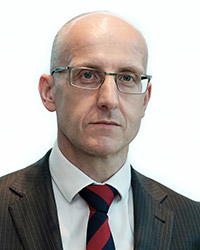

- Paul Byrne
- Group Treasurer, Crisis Restructuring/Management, Strategic Adviser and Interim Executive
The Russian debt crisis of 1998, the dot-com bubble and then the global financial crash didn’t faze Paul Byrne. In fact, he describes 2008 as a ‘fantastic time’ to be in treasury, with all the challenges it brought alongside the opportunities to rebuild businesses and restructure systems. His survival kit includes a can-do attitude, the ability to think strategically, knowing when to take or leave advice – and a pile of good books to read on the road.
How did you come into treasury and what attracted you to the profession?
After qualifying as an accountant, I quickly realised it wasn’t something that I was particularly interested in doing for the rest of my career. At that time, I was working as a financial controller for Citi and began to gravitate towards the trading floor. I became much more interested in the mechanics of funding the bank and less about debits and credits. I was hooked from that point. I knew I wanted to fund the balance sheet and to manage capital and liquidity, hence the move into treasury.
I have been fortunate to have worked for Citi, SEB, Merrill Lynch (where I was treasurer of their banks throughout the global financial crisis), AIG and PTSB (an Irish bank that failed the European Central Bank [ECB] 2014 stress test, which I got to re-IPO and QBE). These firms gave me the opportunity initially to work on individual transactions, including debt deals, equity raising, balance sheet restructuring, crisis management, deleveraging or M&A, which, over time, became a body of work and experience that has enabled me to continue enjoying what I love to do!
Over time, my roles became more geared towards enterprise level and strategic in nature, enabling me to truly make an impact on the business.
How has your career progressed through to the role that you hold today?
As I mentioned earlier, I started out as an accountant, undertaking Financial Controller, Head of Finance and Chief Financial Officer roles, before I secured my first true treasury role in 2001 as International Treasury Director. Then, my big break came at the back end of 2005 when I was offered the role as Treasurer for one of Merrill Lynch’s banks, Merrill Lynch Capital Markets Bank, and it was largely a derivative shop.
Towards 2007, I was promoted to Treasurer of Merrill’s banks. There were eight or nine altogether with an aggregate balance sheet of around US$700bn, and by August 2007 I was in the deep end as the global financial crisis took hold. Overnight funding dried up, ultra-high net depositors were getting nervous and debt markets were locking up and the swap market was broken.
It was the most fantastic time to be in treasury; funding, liquidity and increasing regulatory capital were key and innovation and a can-do attitude were critical. At this juncture regulators, rating agencies and non-executive directors increasingly featured in my life.
Bear Stearns folded, Lehman and Merrill were sold and my role expanded to include some of Bank of America’s offshore banks.
All of the challenges that made 2007-8 fantastic had disappeared by the end of 2009 and I was looking for a new challenge when AIG approached me. They had their own issues to deal with having been bailed out by the US Government to the tune of $180bn, which they were aggressively looking to repay by divesting businesses. They approached me to build a treasury function for their Chartis P&C (property and casualty insurance) business in anticipation of an impending IPO in mid-2010.
A change of Group CEO led to a switch in strategy and Chartis was now considered to be core and not for sale. I was now Global Treasurer of Chartis, having built out the global treasury function, re-engaged with debt markets, unencumbered assets and executed a number of liquidity transformation transactions, upstreaming funds to assist with the repayment of the US Government.
At this time, we believed we would be designated as a SIFI (systemically important financial institution) and we needed a robust contingent liquidity modelling solution, which we built and rolled out across the broader AIG Group. In mid-2014, I was appointed Group Treasurer of Permanent TSB. PTSB was a struggling Irish retail bank that was about to fail the ECB stress test, with a 100% encumbered balance sheet. One of my first actions was to position and plan to avert a potential deposit run as a result of the announcement of the ECB results.
I spent 2014 deleveraging the balance sheet, selling €10bn in assets and using these proceeds to pay down system funding and start unencumbering the balance sheet, telling the story to rating agencies (I secured two upgrades) and debt investors. I also re-priced all of our retail liabilities to drive NIM (net interest margins) and a return to profitability in support of the investment thesis.
At the same time, I was on the road meeting and presenting the investment thesis to potential equity investors and generally preparing the bank for its re-IPO which happened in May 2015. The transaction was 10 times oversubscribed, which saw €500m flowing back to the Irish Government.
My final act for PTSB was to print its first unsecured issuance in ten years. With PTSB well on the way to recovery I was approached to become the Group Treasurer of Australian global insurer QBE and to move my family to Sydney. I built a true group treasury function for QBE, simplifying the international treasury functions, centralising risk management, liquidity, credit facilities and debt issuance. Along the way I claimed a couple of world firsts: the first green bond issued by an insurer and the first and only gender equality bond to be issued as an AT1 instrument, which was 24 times oversubscribed.
I have 100% enjoyed my career to date, having managed through the Russian debt crisis in 1998, the dot-com bubble, the global financial crisis and its aftermath. I have had experiences I never could have envisaged as a fresh-faced accountant, from balance sheet restructuring, crisis management, the importance of stakeholder management, of innovation, understanding the art of the possible and a never-say-die attitude.
Treasury is somewhere you can truly effect enterprise-level change and have a great career.
How have the demands and needs of treasury changed over the course of your career, and what particular skills does the role require today?
As a general observation, the role of a treasurer today is far more strategic and less operational that it was 20 years ago. Given the intricacies of operating in an increasingly complex, regulated global marketplace, I believe the challenge for treasurers is to remain strategic, relevant and abreast of the changing environment. It is vital to create and retain strong relationships with debt investors, lenders and markets and to be a trusted adviser to the CFO, CEO and the board.
I believe the three mandatory skills a treasurer should have are:
What specific, or perhaps surprising, qualities do you look for when recruiting treasury personnel?
I believe participation in team sports can be an indicator that a candidate will work well in a team environment. I have noticed this particularly in candidates who have played hockey or rugby. Similarly, when I see a candidate who has rowed at school, university or for a club, that indicates to me that they are committed individuals because the very early mornings on the water and the hours spent on the rowing machine require a level of commitment.
How important do you think a formal treasury education is, as opposed to (or as well as) more general finance or accountancy qualifications?
I tend to look for candidates who have treasury work experience, not a treasury qualification, over a finance or accounting qualification. I am not sold on the transition from accountancy to treasury. Yes, I know I took that route, but my observation is that accountants tend to struggle more to make the switch than some other candidates.
In your career, what are the major changes that you have seen within treasury in the past five years?
I have been a treasury professional for 20 years, spending most of that time within the financial institution space. When I think of all of the major changes I have seen over the past five years, the key drivers behind all of them flowed from the emotional and financial scar tissue left behind from the global financial crisis, whether this was as a result of:
Based on your career so far, what would your advice be to finance professionals who are perhaps in their first treasury role?
Select the firm you want to work for, understand what you want to get from your first role and how the experience and knowledge you have gained will position you for your next one. Be a good team player, learn as much as you can, ask questions, integrate into the team, don’t be afraid to share your ideas – and have fun and enjoy the job.
What would your ideal holiday be?
Before I moved to Australia, I would have said three weeks somewhere warm and sunny with my family. After almost five years of very warm and sunny days, I think a couple of weeks in a winter setting for Christmas with the family would be great.
What book have you read recently or what film have you seen recently that you would recommend, and why?
I read a lot of books, particularly when travelling with roadshows, and I tend to read a couple of chapters of a biography or autobiography in the morning and a couple of chapters of a historical fiction novel in the evenings – and always historical fiction on the road. At the moment I am reading both Traitors of Rome by Simon Scarrow and My American Dream by Colin Powell. I am reading Powell’s book as I was privileged to meet him and he gave me an autographed copy.
If I can be of any assistance to anybody looking for career advice or to share any learnings from my experiences, I am very happy to do so. Please reach out and make contact via LinkedIn.



